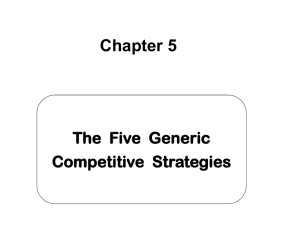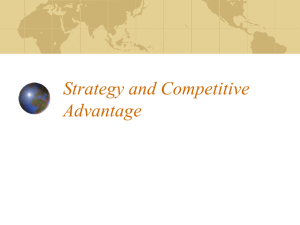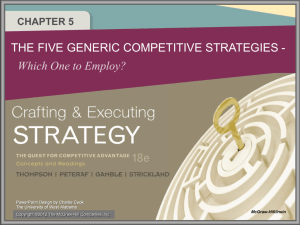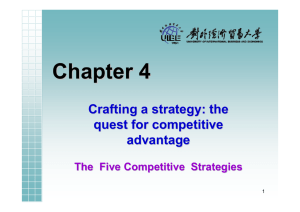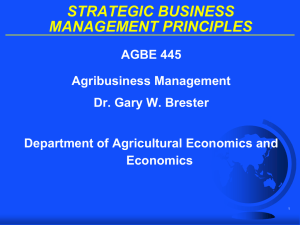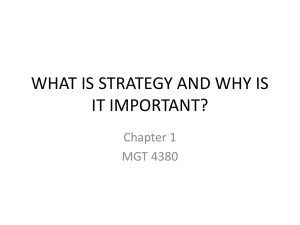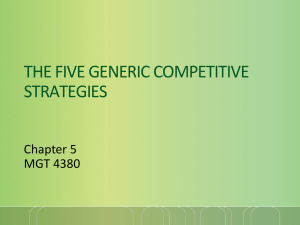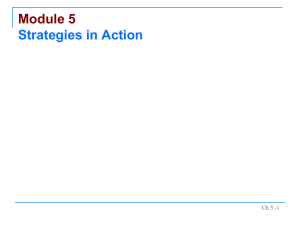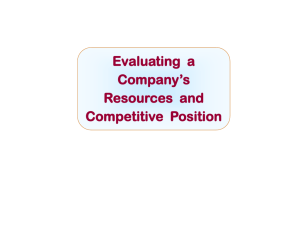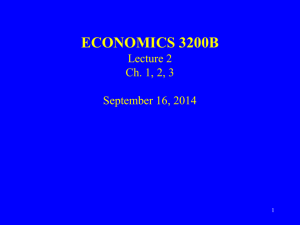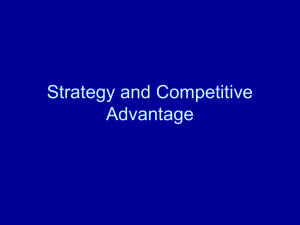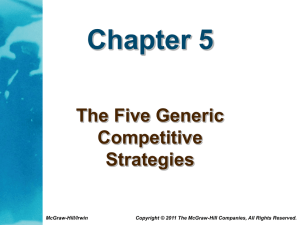Chapter 5
advertisement
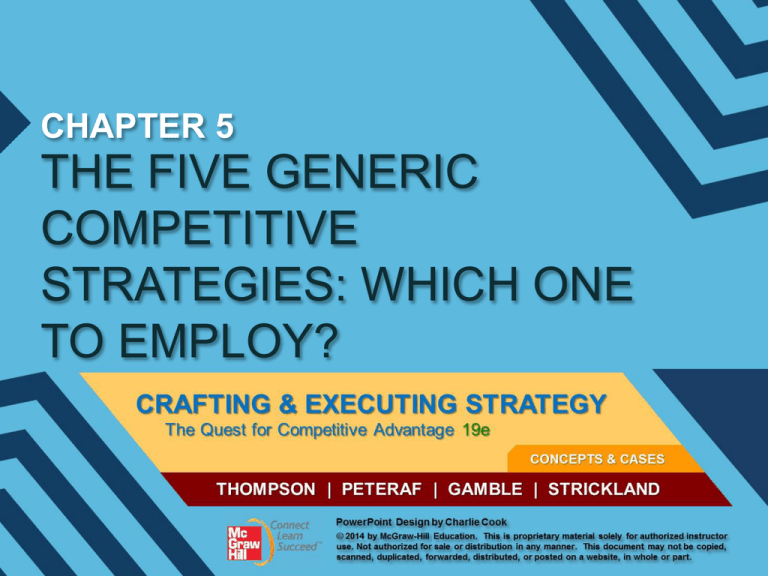
CHAPTER 5 THE FIVE GENERIC COMPETITIVE STRATEGIES: WHICH ONE TO EMPLOY? WHY DO STRATEGIES DIFFER? Is the firm’s market target broad or narrow? Key factors that distinguish one strategy from another Is the competitive advantage pursued linked to low costs or product differentiation? 5–2 FIGURE 5.1 The Five Generic Competitive Strategies 5–3 THE FIVE GENERIC COMPETITIVE STRATEGIES Low-Cost Provider Broad Differentiation Striving to achieve lower overall costs than rivals on products that attract a broad spectrum of buyers. Differentiating the firm’s product offering from rivals’ with attributes that appeal to a broad spectrum of buyers. Focused Low-Cost Concentrating on a narrow price-sensitive buyer segment and on costs to offer a lower-priced product. Focused Differentiation Concentrating on a narrow buyer segment by meeting specific tastes and requirements of niche members Best-Cost Provider Giving customers more value for the money by offering upscale product attributes at a lower cost than rivals 5–4 MAJOR AVENUES FOR ACHIEVING A COST ADVANTAGE Low-Cost Advantage ● A firm’s cumulative costs across its overall value chain must be lower than competitors’ cumulative costs. How to Gain a Low-cost Advantage: 1. Perform value chain activities more cost-effectively than rivals. 2. Revamp the firm’s overall value chain to eliminate or bypass cost-producing activities. 5–5 FIGURE 5.2 Cost Drivers: The Keys to Driving Down Company Costs 5–6 COST-CUTTING METHODS Striving to capture all available economies of scale. Taking full advantage of experience and learning-curve effects. Trying to operate facilities at full capacity. Improving supply chain efficiency. Using lower cost inputs wherever doing so will not entail too great a sacrifice in quality. Using the firm’s bargaining power vis-à-vis suppliers or others in the value chain system to gain concessions. Using communication systems and information technology to achieve operating efficiencies. 5–7 COST-CUTTING METHODS (cont’d) Employing advanced production technology and process design to improve overall efficiency. Being alert to the cost advantages of outsourcing or vertical integration. Motivating employees through incentives and company culture. 5–8 REVAMPING THE VALUE CHAIN SYSTEM TO LOWER COSTS Use a direct sales force and a company website to bypass the activities and costs of distributors and dealers. Streamline operations by eliminating low valueadded or unnecessary work steps and activities. Reduce materials handling and shipping costs by having suppliers locate their plants or warehouses close to the firm’s own facilities. 5–9 THE KEYS TO BEING A SUCCESSFUL LOW-COST PROVIDER Success in achieving a low-cost edge over rivals comes from out-managing rivals in finding ways to perform value chain activities faster, more accurately, and more cost-effectively by: ● Spending aggressively on resources and capabilities that promise to drive costs out of the business. ● Carefully estimating the cost savings of new technologies before investing in them. ● Constantly reviewing cost-saving resources to ensure they remain competitively superior. 5–10 WHEN A LOW-COST PROVIDER STRATEGY WORKS BEST 1. Price competition among rival sellers is vigorous. 2. Identical products are available from many sellers. 3. There are few ways to differentiate industry products. 4. Most buyers use the product in the same ways. 5. Buyers incur low costs in switching among sellers. 6. The majority of industry sales are made to a few, large volume buyers. 7. New entrants can use introductory low prices to attract buyers and build a customer base. 5–11 PITFALLS TO AVOID IN PURSUING A LOW-COST PROVIDER STRATEGY Engaging in overly aggressive price cutting does not result in unit sales gains large enough to recoup forgone profits. Relying on a cost advantage that is not sustainable because rival firms can easily copy or overcome it. Becoming too fixated on cost reduction such that the firm’s offering is too features-poor to gain the interest of buyers. Having a rival discover a new lower-cost value chain approach or develop a cost-saving technological breakthrough. 5–12 BROAD DIFFERENTIATION STRATEGIES Effective Differentiation Approaches: ● Carefully study buyer needs and behaviors, values and willingness to pay for a unique product or service. ● Incorporate features that both appeal to buyers and create a sustainably distinctive product offering. ● Use higher prices to recoup differentiation costs. Advantages of Differentiation: ● Command premium prices for the firm’s products ● Increased unit sales due to attractive differentiation ● Brand loyalty that bonds buyers to the firm’s products 5–13 FIGURE 5.3 Uniqueness Drivers: The Keys to Creating a Differentiation Advantage 5–14 ENHANCING DIFFERENTIATION BASED ON UNIQUENESS DRIVERS Striving to create superior product features, design, and performance. Improving customer service or adding additional services. Pursuing production R&D activities. Striving for innovation and technological advances. Pursuing continuous quality improvement. Increasing emphasis on marketing and brand-building activities. Seeking out high-quality inputs. Emphasizing human resource management activities that improve the skills, expertise, and knowledge of company personnel. 5–15 REVAMPING THE VALUE CHAIN SYSTEM TO INCREASE DIFFERENTIATION Approaches to enhancing differentiation through changes in the value chain system Coordinating with channel allies to enhance customer perceptions of value Coordinating with suppliers to better address customer needs 5–16 WHEN A DIFFERENTIATION STRATEGY WORKS BEST Market Circumstances Favoring Differentiation Diversity of buyer needs and uses for the product Many ways that differentiation can have value to buyers Few rival firms follow a similar differentiation approach Rapid change in technology and product features 5–17 PITFALLS TO AVOID IN PURSUING A DIFFERENTIATION STRATEGY Relying on product attributes easily copied by rivals. Introducing product attributes that do not evoke an enthusiastic buyer response. Eroding profitability by overspending on efforts to differentiate the firm’s product offering. Offering only trivial improvements in quality, service, or performance features vis-à-vis the products of rivals. Adding frills and features such that the product exceeds the needs and use patterns of most buyers. Charging too high a price premium. 5–18 FOCUSED (OR MARKET NICHE) STRATEGIES Focused Strategy Approaches Focused Low-Cost Strategy Focused Market Niche Strategy 5–19 WHEN A FOCUSED LOW-COST OR FOCUSED DIFFERENTIATION STRATEGY IS ATTRACTIVE The target market niche is big enough to be profitable and offers good growth potential. Industry leaders chose not to compete in the niche— focusers avoid competing against strong competitors It is costly or difficult for multi-segment competitors to meet the specialized needs of niche buyers. The industry has many different niches and segments. Rivals have little or no interest in the target segment. 5–20 THE RISKS OF A FOCUSED LOW-COST OR FOCUSED DIFFERENTIATION STRATEGY 1. Competitors will find ways to match the focused firm’s capabilities in serving the target niche. 2. The specialized preferences and needs of niche members to shift over time toward the product attributes desired by the majority of buyers. 3. As attractiveness of the segment increases, it draws in more competitors, intensifying rivalry and splintering segment profits. 5–21 BEST-COST PROVIDER STRATEGIES Differentiation: Providing desired quality/ features/performance/ service attributes Low Cost Provider: Charging a lower price than rivals with similar caliber product offerings Best-Cost Provider Hybrid Approach Value-Conscious Buyer 5–22 WHEN A BEST-COST PROVIDER STRATEGY WORKS BEST Product differentiation is the market norm. There are a large number of value-conscious buyers who prefer midrange products. There is competitive space near the middle of the market for a competitor with either a medium-quality product at a below-average price or a high-quality product at an average or slightly higher price. Economic conditions have caused more buyers to become value-conscious. 5–23 THE BIG RISK OF A BEST-COST PROVIDER STRATEGY—GETTING SQUEEZED ON BOTH SIDES Low-Cost Providers Best-Cost Provider Strategy High-End Differentiators 5–24 THE CONTRASTING FEATURES OF THE FIVE GENERIC COMPETITIVE STRATEGIES: A SUMMARY Each Generic Strategy: ● Positions the firm differently in its market. ● Establishes a central theme for how the firm intends to outcompete rivals. ● Creates boundaries or guidelines for strategic change as market circumstances unfold. ● Entails different ways and means of maintaining the basic strategy. 5–25 SUCCESSFUL COMPETITIVE STRATEGIES ARE RESOURCE-BASED A firm’s competitive strategy is most likely to succeed if it is predicated on leveraging a competitively valuable collection of resources and capabilities that match the strategy. Sustaining a firm’s competitive advantage depends on its resources, capabilities, and competences that are difficult for rivals to duplicate and have no good substitutes. 5–26
